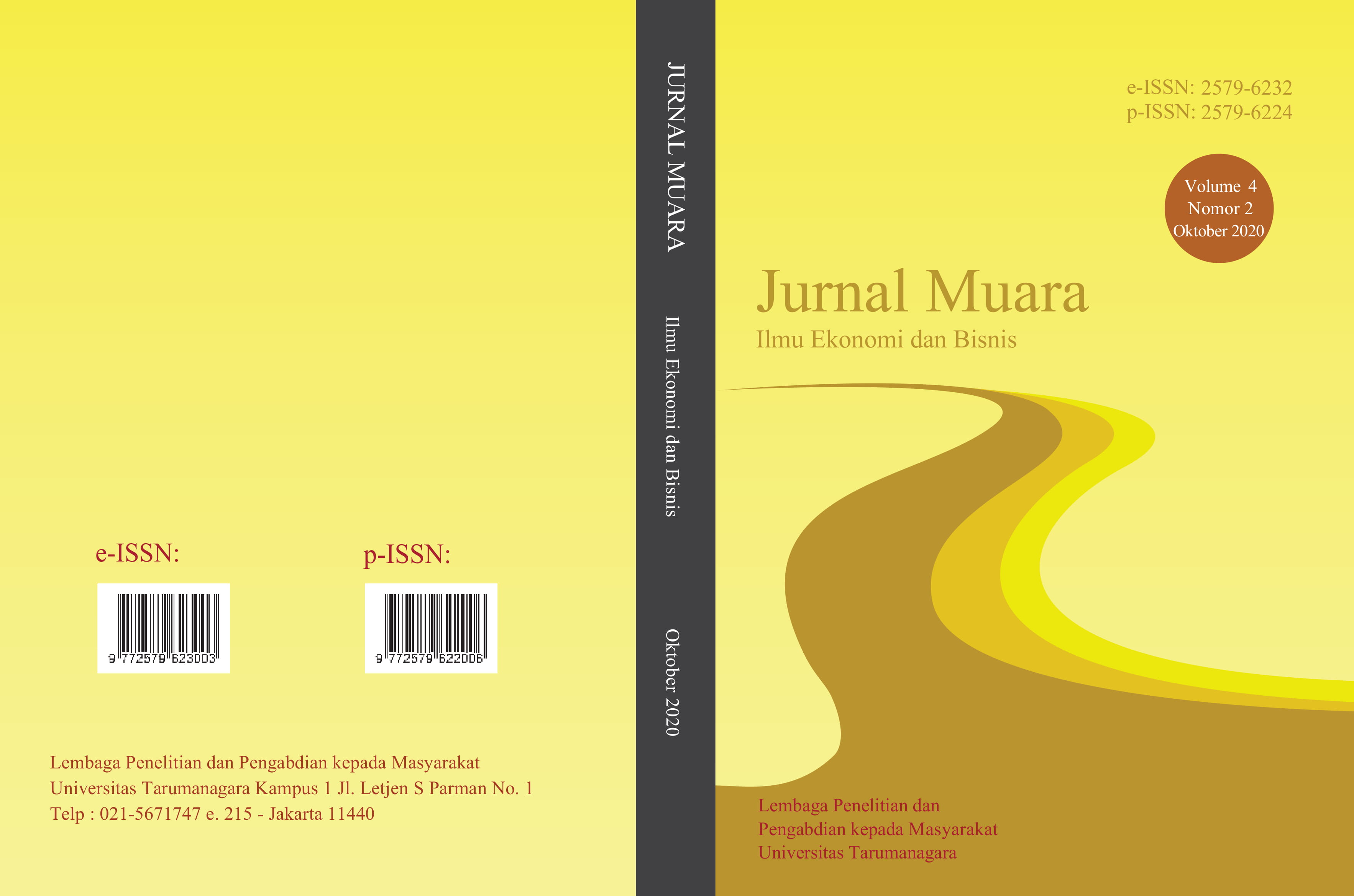EFISIENSI TEKNIS BANK DI INDONESIA: KELOMPOK BUKU I-IV
Main Article Content
Abstract
Efisiensi Bank merupakan salah satu ukuran kinerja bank. Bank harus berusaha mengelola input dan output bank secara optimal. Efisiensi bank yang optimal dapat dilihat dari tingkat efisiensi teknis bank. Penelitian ini bertujuan mengukur efisiensi teknis bank di Indonesia. Penelitian dilakukan pada 38 bank berdasarkan kelompok bank BUKU I-IV periode 2012 – 2018 dengan metode DEAP. Variabel input dan output bank menggunakan pendekatan Intermediasi bank. Variabel input bank yaitu price of fund, price of labor and price of capital. Sedangkan output bank yaitu loans. Pengukuran efisiensi teknis menggunakan DEAP sebagai pengukur efisiensi secara modern. Hasil penelitian metode DEAP dengan model Constant Return to Scale (CRS) menunjukkan bahwa Bank BNI dan bank BCA paling efisiensi secara teknis dibanding bank lainnya dengan efisiensi teknis 100%. Bank kelompok BUKU IV secara umum telah mencapai efisiensi teknis sedangkan Bank kelompok BUKU I-III belum mencapai efisiensi teknis. Pada periode 2018, dalam mencapai efisiensi teknis maka kelompok bank BUKU I-III harus melakukan kebijakan dengan cara mengendurkan atau mengurangi biaya dua input. Kedua input variabel yaitu input price of fund dan price of capital karena kedua input tersebut yang membuat bank belum mencapai efisiensi teknis.
Efficiency of Bank is a measure of bank performance. The banking sector must try to regulate bank inputs and outputs optimally. Optimal efficiency can be seen from the bank's technical efficiency score.. This study aims to measure the technical efficiency of banks in Indonesia. The study was conducted on 38 banks based on the BUKU I-IV, period 2012 - 2018 with the DEAP method. Bank input and output variables use the bank intermediation approach. Bank input variables are price of funds, price of labor and price of capital. Bank output is loans. Measurement of technical efficiency using DEAP as a measure of modern efficiency. The DEAP method research results with the Constant Return to Scale (CRS) model show that BNI Bank and BCA bank are the most technically efficient compared to other banks with 100% technical efficiency. BUKU IV group banks in general have achieved technical efficiency while BUKU I-III group banks have not technical efficiency. In achieving technical efficiency, the BUKU I-III bank group must carry out policies by relaxing or reducing the costs of two inputs. The two variable inputs are input price of funds and price of capital because these two inputs have made the bank not yet reached technical efficiency.
Article Details
Section
References
Balcerzak, A. P. et. e. (2017). Non-parametric approach to measuring the efficiency of banking sectors in european union countries. Acta Polytechnica Hungarica, 14(7), 51–70. https://doi.org/10.12700/APH.14.7.2017.7.4
Bank Indonesia. (2018). Penguatan SSK Dalam Upaya Menjaga Momentum Pertumbuhan (2620-9241). Indonesia.
Coelli, T. J. (2005). An Introduction to Efficiency Analysis. (Second). United States: Springer Science & Business Media.
D.hadad, M. W. S. (2003). Pendekatan Parametrik Untuk Efisiensi Perbankan Indonesia.
Grmanová, E., & Ivanová, E. (2018). Efficiency of banks in Slovakia: Measuring by DEA models. Journal of International Studies, 11(1), 257–272. https://doi.org/10.14254/2071-8330.2018/11-1/20
I.Papanikolaou, M. D. D. N. (2009). Determinants of Bank Efficiency : Evidence from a semi - parametric methodoloy. Economic Policy, (2116), 0–33. https://doi.org/10.1227/01.NEU.0000349921.14519.2A
Lee, Y. J. (2017). An Analysis of Korean Bank Performance Using a Double Bootstrapped DEA Analysis, XVII(2), 48–64.
Périco, A. E., Santana, N. B., & Rebelatto, D. A. do N. (2016). Estimating the efficiency from Brazilian banks: a bootstrapped
Data Envelopment Analysis (DEA). Producao, 26(3), 551–561. https://doi.org/10.1590/0103-6513.185714
Sari, P. Z., & Saraswati, E. (2017). The Determinant of Banking Efficiency in Indonesia (DEA Approach). Journal of Accounting and Business Education, 1(2), 208. https://doi.org/10.26675/jabe.v1i2.8489
Sharma, A. K., Sharma, D., & Barua, M. K. (2012). Efficiency and Productivity of Indian Banks : An Application of Data Envelopment Analysis and Tobit Regression, (January 2016), 81–90. https://doi.org/10.13140/RG.2.1.2827.6886
Stewart, C., Matousek, R., & Nguyen, T. N. (2016). Efficiency in the Vietnamese banking system: A DEA double bootstrap approach. Research in International Business and Finance, 36, 96–111. https://doi.org/10.1016/j.ribaf.2015.09.006
Tlig, H. (2013). A Fuzzy Data Envelopment Analysis model to evaluate the Tunisian banks efficiency. International Journal of Scientific & Engineering Research, 4(9), 1924–1929. Retrieved from http://www.ijser.org
https://ojk.go.id/id/data-dan-statistik/laporan-tahunan/Pages/Laporan-Tahunan-OJK-2018.aspx

